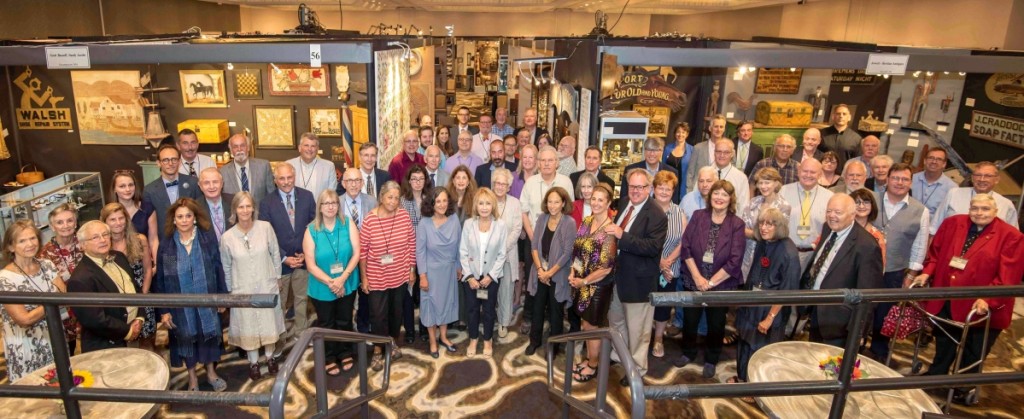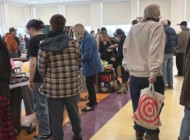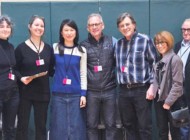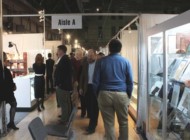-1024x682.jpg)
Sales with Hollis E. Brodrick, Portsmouth, N.H., included a mirror, a hanging cabinet, an engraving and a book.
Review and Photos by Madelia Hickman Ring, Additional Photos by Greg Smith
MANCHESTER, N.H. – The last show to open during Antiques Week in New Hampshire is the New Hampshire Antiques Show, hosted by the New Hampshire Antiques Dealers Association (NHADA) and open August 6-8, three dynamic days at the Doubletree by Hilton Hotel in downtown Manchester. Playing host to 64 dealers, many who have been doing the show for years, it is the culmination of the week and welcomes several hundred visitors for the opening bell alone.
“Go more than once if you can!” was the sentiment expressed to this reporter by Jeff Noordsy during a post-show conversation: the importance of attending every day the show is open. Not only do many dealers replenish depleted stock with fresh, unseen things, but with thinner crowds on the second and third days, it is often possible to see more of the great things on offer throughout the floor, many of which have been in place since the show opened. It was a comment voiced by many dealers after the show.
Sharon Platt, the NHADA’s vice president for communications, commented, “The gate was up this year. We are proud of our increased focus and presence on social media, on Facebook and Instagram. Exhibitors save objects throughout the year, and this is one of the aspects that adds to the magic and high collector energy of The New Hampshire Antiques Show. Sales were phenomenal throughout the show, from high-end Americana to memorabilia and folk art. There is something for everyone at all levels.”
Beverly Weir-Longacre, one of the two co-chairs for the show, said, “As in the past years, we had a group of enthusiastic NHADA customers waiting in line for four hours. By 10 am, the line was out the door. Inside the show, customers were enthusiastic and knowledgeable and enjoyed the many wonderful items that the dealers had saved for months just for this show. And as always top-notch dealers, top-notch merchandise and top-notch customers, a wonderful week for antiquing in the beautiful state of New Hampshire.”
“The show was exceptional,” said Edwin “Ed” Hild of Olde Hope Antiques, Inc, a few days after the show wrapped. Hild said his first sale, which came within minutes of the show opening, was a private client whose wife was not able to attend the show but had loved a carved tulip decoration she had seen in a photograph on Instagram; her husband bought them for her as an anniversary present. In addition to a five-hour stretch of selling on opening day in multiple price ranges, Hild characterized business on Friday as “surprising,” with some of the pricier sales of the show – a carved dog by Gus Wilson and a carved pig. He also said they had two West Coast couples who came to the show on all three days, buying each day.
-1024x683.jpg)
The aisles and booths were packed with more than 500 people who waited in line for the opening bell on Thursday, August 8.
Peter Sawyer, whose booth was right across the aisle from Olde Hope, had a similarly good show. “I think most dealers would agree business is picking up. We sold chests of drawers, tall clocks, paintings, mirrors and many accessories to people from all over the country, including California, Colorado and Texas. As always, smalls are popular at this show, but larger items were selling as well. I feel enthused about the marketplace! It was much stronger than I anticipated.”
When asked which pieces were particularly important, Philadelphia needlework dealer, Amy Finkel of M. Finkel & Daughter pointed out several, some of which sold during the show. These included a sampler worked in 1818 by Mary Stocker at Mary Walden’s school in Portsmouth, N.H., and virtually identical to one at the Baltimore Art Museum. Other sales included a rare silk embroidery worked by Elmina Clarinda Walker around 1820 in Rutland County, Vt.; a good Virginia sampler and a Scottish sampler; as well as others, including one of the tin works on the outside of the booth. “The show attracts, as always, an intelligent, buying, happy crowd,” was Finkel’s summation after three busy days.
The show welcomed one new dealer this year: David A. Schorsch-Eileen M. Smiles, from Woodbury, Conn. Speaking after the show, Schorsch said, “The NHADA show is wonderful to do as an exhibitor. The association does a terrific job in making all facets of the experience easygoing and extremely well organized, from beginning to end. In terms of sales, they were vibrant and varied in a wide-price range, from a few hundred to tens of thousands.
“Among our more than a dozen sales to both dealers and private collectors were two Philadelphia fire parade hats, a gamecock weathervane in original surface, an 1805 New Jersey fraktur formerly in the Garbisch and Sussel collections, a merganser decoy by Jester, a Salem mahogany serpentine top candlestand with original finish, a signboard inscribed “Friendship,” a signed and dated Manchester, N.H., portrait of a child in a red dress and an important large full-length portrait of a brother and sister by J.A. Davis that was included in the landmark exhibition ‘Three New England Watercolor Painters.’ We’re thrilled to have been included in this phenomenal and unique Americana event.”
Like Schorsch, many exhibitors were offering works that have appeared, at one time – or several times, in the myriad publications on American furniture, folk art and decorative arts. It was not uncommon to see objects with books documenting their publication. These included, with Hercules Pappachristos, a spectacular fancy painted side chair attributed to John Seymour Jr, a mate to one illustrated in Robert D. Mussey Jr’s The Furniture Masterworks of John & Thomas Seymour (2003) at the Peabody Essex Museum with history in the Silsbee-Derby-Crowninshield families. Sitting front and center of the booth of Elkins, N.H., dealer John H. Rogers was a painted rocking chair with extended crest that had been published in Jean Lipman and Alice Winchester’s The Flower of American Folk Art (1776-1876).
-1024x682.jpg)
With Nathan Liverant and Son, Colchester, Conn., were, clockwise from upper right, a portrait of Caroline A. Pease holding flowers above a geometric inlaid tall chest attributed to Harrison Webber of Reading, Penn., a William and Mary linen fold-carved blanket chest from the Connecticut River Valley and a portrait of a sea captain attributed to Fredrick Mayhew.
The booth down the aisle from Schorsch was that of New Oxford, Penn., dealer Kelly Kinzle. Of particular interest to Kinzle was a near life-size iron figure of a Native American that he thought had been a building ornament and which still had some of its original paint, and three silver fire trumpets that he said were rare because they were solid silver instead of silverplate as many are. The variety of his offerings included two militia drums – one from Massachusetts, the other from New York; a view of New York City from Weehawken, N.J., by W.H. Bartlett; a Bellamy eagle; and a Pennsylvania paint-decorated corner cupboard.
When Antiques and The Arts Weekly caught up with Kinzle the day the show closed, he said he was very happy, reporting sales on all three days, including an E.C. Coates painting, as well as several other paintings, a bonnet top chest on chest, stands and a Babe Ruth photo.
Jason Hackler of Jason Samuel Fine Art & Antiques, Milford, N.H., was around the corner from Kinzle, and his booth was dominated by a panoramic landscape by Paul Starrett Sample (1896-1974) that depicted the Verney Farm of Bennington, Vt., in winter. In the back corner, a Pennsylvania grain-painted corner cupboard housed four works by American art potters Edwin and Mary Scheier. The pieces ranged in price from about $350 to $2,400. After the show, Hackler said, “We sold a couple of pieces of Scheier pottery, architectural elements, a good painting and a few pieces of Adirondack furniture.”
Christopher Evans does about ten shows a year but says this is his most important. He took a few minutes before the show opened to explain that it is curated to bring in a good variety of dealers who field not just diversity in offerings but in price points as well. He attributed the large number of attendees to the fact that dealers save not only fresh-to-the-market objects but the most unusual as well. He explained that it is critical that buyers – particularly beginning collectors – have access to great things in every price band. The Waynesboro, Va., dealer pointed out several things in his booth that he said were exceptional or unusual for different reasons, all of which were priced for less than $5,000.
“We sold a lot of pottery – redware and stoneware – and a lot of Shaker, with several good things selling on Friday and Saturday,” he said by phone afterwards. Evans said he holds things back to bring out on the second and third day, something many dealers do. He said about two-thirds of his sales were to clients new to him and thinks the social marketing efforts are effective.
-1024x682.jpg)
Social media was directly responsible for the sale of this carved tulip sculpture, which was purchased by a client as an anniversary gift for his wife, who was not able to attend the show, but who saw it on Instagram. Edwin “Ed” Hild and Patrick “Pat” Bell, Olde Hope Antiques, New Hope, Penn., and New York City.
Jewett-Berdan Antiques had a large booth that faced the upper floor. A standout piece, which was featured in its show ad, was a dressing table from Maine attributed to William A. Mason of Fryeburg, Maine, circa 1829, and related to an example illustrated in Dean A. Fales Jr and Robert Bishop’s American Painted Furniture 1660-1880. Tom Jewett said, in a follow-up email after the show, “The show ended up very good for us and we are grateful for all our old clients and new ones…Crowds seemed very strong. We save all year for this show and just love it…Some of our sales consisted of a good painted folk art whirligig, three painted gameboards, painted boxes, three exceptional weathervanes, many painted smalls, a folky quilt, baskets, a rare painted six-board blanket chest, a couple of hooked rugs, carvings and a few trade signs just to name some of our sales…We are already preparing for next year’s show.”
“In my opinion, this show is the Super Bowl of New Hampshire every year – it’s just a great happening,” said Highland Park, Ill., and Sunapee N.H., dealer, Barbara Pollack. “For me, it’s a reunion every year, to see people I don’t see the rest of the year.” She reported considerable interest in many things, including a raised work table cover found in Maine, a Gus Wilson scoter decoy, an Odd Fellows fireplace surround in vibrant red, a set of five portraits of bulls and cows painted “from life” by J.F. Stephens of Savannah, Mo., and a three-piece child’s size green painted wicker furniture suite. She was delighted to have sold a Bucks Co., miniature green and yellow paint-decorated blanket chest on the first day.
“I’ve done this show for 47 years and this show has to be right up there with the best three or four,” said Stephen Corrigan of Stephen-Douglas Antiques. The Rockingham, Vt., and Walpole, N.H., dealers reported selling a little bit of everything, including a set of four portraits by “Mr Wilson,” to clients from California who were attending the show for the first time, and a diminutive Pennsylvania silk needlework picture that the dealers had featured in one of its show ads. “There’s always a new group of people coming, sometimes from faraway places. When you can draw multiples of people from across the country, it says something about the importance of the show.”
Eclectic is the buzz word for Bruce Emond at Village Braider. A fabulous red and white painted tin barn wall cover – which was not for sale during the show but is now available to purchase – provided the perfect backdrop for the selection of garden ornaments and architectural elements the Plymouth, Mass., dealer had brought. In his second year doing the show, Emond said it was “good.” He wrote about 30 receipts, mostly to new clients, throughout the run of the show and even during set up.
New Haven, Conn., dealer, Fred Giampietro, was going for an arguably modern, “less is more” philosophy when it came to the layout of his booth, which had an open, airy feeling to it. Front, center and dynamic from any angle was a vibrant Cushing & White Liberty weathervane. A violin from New York State had a scroll carved as the head of a baseball player. Giampietro said it had been made around the time of the Civil War. When reached afterwards for comment, he said, “The show was great. Lots of activity and strong sales. Some good spotty higher priced sales, a good sign for the market. We sold items all three days and sold 80 percent of what we brought. We also sold three items that were posted on social media by showgoers.”

Shown here are most of the 64 dealers participating in the 62nd Annual New Hampshire Antiques Show. John Gauvin photo, courtesy Studio One.
For a dramatic effect, it would be hard to beat five large framed works comprised of colored pencils arranged artfully that were with Boston dealer, Stephen Score. He had found them in Iowa and said they were midcentury. One followed the layout of a baseball field and included pencils shaped like baseball bats. Score sold early furniture, painted furniture and smalls and a four-drawer chest. He mentioned that dealers needed help in the booth during the initial rush or they risked losing a sale. “It’s a lovely show, attracts buyers with passion for the objects.”
Jeff Noordsy could not have been more enthusiastic about his tenth year doing the show. “It was fantastic! Our best one ever, I think, maybe not in terms in overall dollars but in terms of items sold. We sold 53 things, a lot between $300 and $1,800. We had some younger collectors; it was a really good mix. Last year we sold a lot but were selling three or four things to one person; this year we only had a couple of multi-item buyers.” The Cornwall, Vt., dealer thought they had about 25 or 30 new customers and attributed the magic of the show to the freshness of the property and the diversity of dealers.
Darnestown, Md., quilt and jewelry dealer, Stella Rubin was similarly positive. “I am pleased to say that Manchester continues to be one of the few remaining antiques destinations. The opening day crowd gives dealers the boost we all need to remember that there are serious collectors who are still passionate about what we offer. I think it was wise for the show to change their policy and now encourage posting on social media. There’s a big world out there of people who can’t make it to the show but want to see what’s available.”
Celebrating his 15th year at the show was Colchester, Conn., dealer Arthur Liverant, who said, “the show was very good; I’m very happy.” He characterized the show as fun, relaxed and a wonderful mix of material, from serious to fun, as well as a camaraderie among dealers. Some of the sales with Nathan Liverant and Son during the run of the show included a silk needlework picture of Moses in the Bullrushes that was worked at the Patten School in Hartford, Conn., a hanging cupboard with blue-green paint and a child’s William and Mary blanket chest with ball feet.
Another exhibitor returning for the 15th time was Manheim, Penn., dealer, Steven Still. He said he had a very good show, and sold a variety of things, including furniture, weathervanes and paintings, with most of the sales taking place on the first day but some on the second and third days.
While many exhibitors reported a strong show, that was not the case for everyone. John Chaski said he had sold about 30 items but with the most expensive item being $1,600, the show was not as good a show as he had hoped. He said there were many good collectors who did not come to the show.
Portsmouth, N.H., dealer Jonathan Trace had several early American and British portraits to accompany his extensive silver offerings. These included portraits of the Reverend Cyprian Strong and his wife, Abigail H. Strong, by William Jennys; portraits of Mrs Freake Wolcott Kitchen and her husband, Edward Kitchen, by the Pierpont limner. After the show closed, when asked about his sales, Trace said, “It was a good range of silver, some furniture, early metalware. This and Delaware are the only shows we do.”
Scott Bassoff and Sandy Jacobs of Swampscott, Mass., reported selling “very well across the board.” Sales included a Baltimore album quilt, a Shaker sewing desk, Americana, a trade sign, folk art and jewelry.
Woodbury, Conn., dealer Nancy Fishelson had advertised a folk art swan decoy from North Carolina with provenance to Kinnaman and Ramaekers; it perched on a shelf next to a painted wall cabinet that sold. Other sales included a carved and painted figure of an angel, a lidded one-handle basket and a blue-painted blanket chest. With Tucker Frey, Woodbury, Conn., was a cow weathervane stamped “Harris,” a circa 1800 six-drawer tall chest from New Hampshire and a painting of the Schooner Baracoa.
“It continues to be our best and most enjoyable show of the year,” was the sentiment expressed by Gene and Nancy Pratt. “We had excellent sales across all categories, including painted furniture and accessories, folk art, early lighting, hooked rugs and paintings. The crowd was enthusiastic as usual. We are very appreciative of the opportunity to take part in this premier show and are always thankful to all the NHADA volunteers that make it all happen.”
A standout in the booth of Thomasville, Penn., dealers Newsom & Berdan, was a Virginia Queen Anne tray top tea table with a foot similar to ones from the Rappahannock River Valley. Sales for them included cupboards, quilts, a barber pole, samplers and a large game wheel.
Adam Irish, director for the NHADA, stocks his booth according to a theme, which for this show was “The Space Between.” A card describing the theme read, in part, “These objects survey the gray area, churn in permanent flux, stake out locations nowhere in particular…and each opens seams in time, space and the mind.”
Judith & James Milne sold from their advertisement in Antiques and The Arts Weekly’s special show section. A cast zinc auto repair sign featuring ten stacked plaques went out the door early on, as did a Nineteenth Century cigar store figure carved by Samuel Robb of New York City, a shooting target, a parcheesi gameboard and a bee weathervane.
“Fun and colorful…I stay away from serious stuff,” said Cassopolis, Mich., dealer Douglas Wyant, whose booth was stocked with just that. Early sales included a triangular pennant that read “United States” and a carved and painted pheasant wall plaque.
Paul Sullivan said, “The show was very good. I did business on Friday and a ton of business on Saturday.” He reported his sales included a print of Queen Victoria, a Chinese export chair, a Boston armchair and lots of smalls. Thomas Longacre has been in business for 43 years. He and Beverly, the director/show co-chair, were the only dealers at the show to bring a large selection of Christmas antiques. NHADA president, Tommy Thompson has been doing the show for 35 years and said he sold his “usual stuff,” to a few new clients.
The lobby outside the show housed the loan exhibition, “Gerry Williams and Friends,” a display of approximately 60 pieces of midcentury studio pottery. Williams (1926-2014) lived and worked in New Hampshire for more than 50 years. He was one of the most influential potters of his time, teaching hundreds of other potters. With his wife, Williams founded Studio Potter magazine, and he was its editor for more than 30 years. He was appointed New Hampshire’s first Artist Laureate in 1998. The loan exhibition was curated by Rick Russack and two of Williams’ daughters: Shelley Williams Westenberg and Jennifer Oliver. It was supported by Devin Moisan Auctioneers, Inc, Epping, N.H.
The 63rd edition of the New Hampshire Antiques show will take place August 6-8. For information, www.nhada.org.

-1024x558.jpg)
-1024x682.jpg)
.jpg)
.jpg)
.jpg)

.jpg)
.jpg)
.jpg)
.jpg)

.jpg)
.jpg)
.jpg)
.jpg)

.jpg)
.jpg)

.jpg)
.jpg)
.jpg)
.jpg)
.jpg)

.jpg)

.jpg)
.jpg)

.jpg)
.jpg)


.jpg)
.jpg)
.jpg)
.jpg)
.jpg)

.jpg)
.jpg)
.jpg)
2.jpg)
.jpg)
.jpg)
.jpg)
.jpg)
.jpg)
.jpg)
.jpg)
.jpg)

.jpg)
.jpg)
.jpg)
.jpg)
.jpg)
.jpg)
.jpg)
.jpg)
.jpg)
.jpg)
.jpg)

.jpg)

.jpg)
.jpg)
.jpg)
.jpg)
.jpg)
.jpg)
.jpg)
.jpg)

.jpg)
.jpg)
.jpg)
.jpg)
.jpg)
.jpg)
.jpg)
.jpg)
.jpg)
.jpg)
.jpg)
.jpg)
.jpg)


.jpg)
.jpg)
.jpg)
.jpg)

.jpg)
.jpg)
.jpg)



